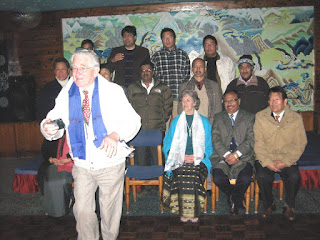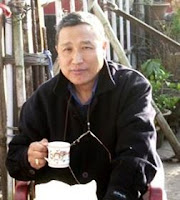To Sir with Love and Gratitude For ‘a feast of
memories’
Rev. John Johnston, who passed away this morning in
Tasmania, wrote this letter to us after his trip around the world with Mrs.
Johnston in 2010.
Dear Friends around the world……
This may not be of great interest to
everyone who received my “Christmas” letter last November; but I did promise to make a “report” of the
expedition outlined then. Many of the
‘reportees’ are those whom we met in India between Nov 24 and March 8, so it’s
easier to go back to the email IDs I used before, and I trust others in UK etc. will enjoy the ride!
I realised after some working of the old
memory, that mostly this is a Hermonite report….. In our notes I can make out
over 100 Hermonites, students, staff and TTCs with whom it has been our
privilege to make connections… so you will appreciate too much detail would be
overwhelming! and I apologise to any who
may feel “left out”! During the course
of these weeks we have covered a history going all the way from Val’s first
contact in 1953,until our final visits from DGH in 2002….almost exactly 50
years of beloved Mount Hermon. Also I find there are nearly a dozen
“places” where these connections were made. We started in Perth when a touchdown there enabled us to meet
Ranjit’s lovely daughter Shaheen (one of my junior monitors in 1986) and HER
daughter Rachael
The next bit of course is part of more
recent history, when we spent the first weeks at our last Indian home, Barnes School,
Devlali. Even here MH caught up with
us, as the new Principal Bryan Martin, V-Principal Trevor Jacob, and long time
staff member, Brian Fernandez are all ex-TTC.
It was part of our “working holiday” to enter into the Barnes
activities….chapels, dorm prayers, matrons’ meetings, blessing of new dorms and
swimming pool, rehearsals for a splendid Christmas programme, Sports Day heats,
and of course lots of interest in our former 8s and 10s who were getting ready
for this year’s ICSE and ISC.

Taking an outing from Devlali we enjoyed
meeting up with former staff, Frank and Val Freese in Pune, and inspecting
Frank’s two wonderful new schools, extensions of Bishops, where Hermonite TTCs
and staff, Henry & Hema Soggee, and Ferdinand Bunyan are in charge. Also mention should be made of Shalini (
another of my 80s monitors) and her “little” sister, and Mrs.deSousa (widow of
Norbert) and old MH and Darjeeling
friend, Mrs. Nuges Madan.
From Devlali we went to South
India for almost a week with Mrs.Mathai and Shanta, and latterly
meeting George and his family, and former staff, P C Mathews and his
family. That week deserves a whole
letter to itself, it gave so much pleasure!
But
then it was off to Kolkata via Cochin and Bangalore (sad not to be able to meet up there with a
whole list of friends from Coonoor days.)
It was wonderful to be met by Sujit and Dipak from the plane at
midnight. Courtesy of Sujit (via Manoj’s
P.O. connection) and Dipak’s India Oil connection we enjoyed first-rate guest
house accommodation in Kolkata. Our
Christmas day visit to St.Pauls was a lovely experience and even there MH
cropped up! Anjali’s choir (sadly for the occasion without Anjali)
lifted our spirits, and a bit of old Darjeeling
came up there when we met Jogen Khan (ex-St.Pauls) and Mary Ann Das Gupta
(ex-Calcutta Girls). For
years Kolkata Hermonites depended on Anup and then Santosh, so it is great to
see Sujit, Dipak, Sajan, Dipkantha and Dibyendu carrying on the good work. Sujit, with much help from may others,
finally got dates from us(!) and later organised a great get-together on Jan
9th. There must have been between 40
and 50 at Hathi’s place, and Sujit has prepared a full set of pics of that
occasion, and a complete list of Kolkata Hermonites…..thanks Sujit! As usual we also enjoyed a lovely meal at
Sajan’s with the old timers, including Rajeev; Singhanias have a 2 generation
connection with MH! Prabir mounted a
great outing to his ancestral home for several of us, including Anjana, Anup’s
sister, who was one of Mrs.J’s senior girls in 1953….time goes by !

In between the two sessions at Kal we went
to Siliguri, from where we were able to visit Kalimpong - only 4 hours thanks
to the Gurkha agitation, but time to
visit Gyanu Rongong, Binod Yonzon and his
fine son Sidarth, Gandhi Ashram (sadly now without Fr.McGuire) and the sisters
at St.Josephs convent . The Siliguri
visit in the hands of Ravi and his sons ,
along with Rajendra, Kavita and family,
and Sushil was really wonderful …how proud we are of
these fine young(?)people. After
Kalimpong the Lakhotia vehicle took us on to Gangtok to be guests at the famous
Tashi Delek Hotel. A sensational
morning visit to Hanumantok with Motilal Lakhotia left us with wonderful images
of the Kanchenjunga range for our digitals
! The next day was one of the
Highlights of our travels, when no less than 17 Sikkim Hermonites enjoyed
dinner at the Hotel….among all the boys it was special to have Nim and Yanki
Shipmo! A great experience to see “my”
students from the 80/90s mixing with our old timers from the 60/70s. We were also proud to be the guests of
Sikkim’s new Minister for Education, Narendra Pradhan, at a conference for his
teachers, supported by another Hermonite, Roshni Pradhan……Dr.Uttam, and several
others came again to the hotel next morning…….a feast of memories.

Besides THE Reunion during the second
session in Kal, other highlights were meetings with the S K Agarwals ( Parents
of Rashmi, Divya and Priya), Ramdin and Mridula, Yasmin Mukand, old Committee member Alfred
Martin (and Arpita), and DGH ex-Principal Bernard Brooks. Also Dipkantha was able to fix a meet with
Subirmal Chakraborty, now Principal of La Marts, where we also met Anjali who
teaches there too. A final meeting
was with Aparna, and a ride with Runa to see Carol & Benu’s new apartment
and meet Anuva. Senior girls from
the 80s will be interested to know of Ma’am’s visits with Sr.Decklen
(St.Josephs K/P) in Siliguri, Sr.Stella
( Loreto Dj.) in Kolkata Loreto (both of them now very unwell) and Sr.Cyril at
Sealdah Loreto. Then all too soon
Sujit and Dipak saw us onto the train for Delhi, and all we had planned was
history.
The Delhi
phase is very much Firdausi’s story !
From her first appearance at the Station to whisk us off to her
apartment (if anyone can whisk anybody in Delhi!!)
until we left nearly a month later, she was our guardian angel. (Firdausi Rahman was the star of 4 musicals
in the 80s !). As with Kolkata the
Delhi visit was in two parts…a week of various visits….Dr.Navreet Singh; Ex-TTC
Troy Calvert, Head at Frank Anthony School; the Lalls from Soom Tea
Estate; ex-TTC sisters at Ashok Vihar
school, courtesy Thinleys’ taxi; meals
with Rajendra’s family (sadly in Delhi because of Anand’s accident); with
Ritesh and his lovely wife and daughter; and an outing with Lance Fuller –
ex-TTC and ex-DGH Principal. Then a
quite wonderful luncheon Firdausi organised for nearly 20 Hermonites at a very
smart hotel at the end of the week……Sashikala, Ayinla, Pema, Anita, Beauty,
Jasmina,Naveen, Harsh, Dipak, Gita,,…..even ex-TTC Andrew Hoffland, and so many others (photos in Facebook) not
least Firdausi’s beautiful little girl, and her honorary Hermonite husband Matthew,
and Beauty’s daughter who is ditto her mum..
Then Mehaboob took us for two nights to stay in Meerut with his family. There we also met Patricia Ismail and her
family…..

Then the scene shifted to Dehra Dun, for a
week with ex-TTC/staff Tashi and Tsering Dhondup, and 10 days with Namla Tsarong,
where Ma’am did a workshop for the Monks and Nuns of the Tibetan centre where
Namla has been director with Norzin assisting……what a thrill also to welcome
Rigzin all the way from Dharamsala (for many years Secretary to His Holiness),
and have tea with him and Sopal Tethong (Matron in 1953), and also with Namla’s
brothers and parents. Tashi
&Tsering organised a meal for us to meet Rockey Gardner and Charlotte,
Debasis Brahma with his wife… Thinley and his wife…..wonderful! I also managed to squeeze in a visit with
Debasis to Doon School, where he works, and a visit with
Barnes ex-Principal and ex-DGH, Albert Temple to see his new school.
A very special item at this stage was a 3
day visit to WynbergAllen in Mussoorie…(where we were happily settled in 1977
until Mr.Murray came and called us back to MH !) The new Principal, Leslie Tindale was our
student in class 7 and 8… and our art teacher Mr.Misra and steward Terence
Cashmore are still there. Mussoorie
holds many happy memories for us with Jenni and Lyndy…..I think I took most
pics of Mussoorie!!
Then a few more days with Firdausi, where
she hosted visits from Krishna, Shibesh and
Narottam, and Joysree & AK;
then we were on our way to
Devlali to finish where we started, at
Barnes. There a special visit from Pune by Jayanta kept MH in
sight. Finally a couple of days in
Mumbai to have a meal with Indranil and his new wife Sweta (all the way from
Patna)….and a time with Tehmi Master, daughter of Dr.Master whom Hermonites of
the 60s will remember…..a bitter sweet meeting since it was the first time
seeing Tehmi since Mrs.Master passed away last year at 92.
Now if you think “this is more than
enough”, find room for two more days….. in Singapore with 80s ex-staff Sunny
Mathai and his delightful family…but after 4 months it WAS nice to land in
Melbourne, to be met by Kris and Jenni’s big girl Annie, for whose graduation
we remained a few weeks more in Melbourne until finally reaching Tasmania in
April ...Now greetings to all…. And the last question, when and where
next ??!!
John
& Val, April 2010
























